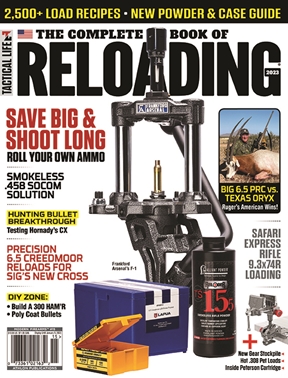Season 3 of Reloading Zone is HERE!
We’re back with Season 3 of Tactical Life’s Reloading Zone, and we’re going progressive!
Join our host Frank Melloni as he dives into progressive presses and caliber conversions. With the help of Hodgdon and Frankford Arsenal, Frank walks us through each step of the process and then tests it all out on the range. From 9mm to 5.56, Frank teaches us everything we need to know.
Episode 1: How do Progressive Presses Work?
If you’re involved in one of the high-volume shooting sports like IDPA or USPSA, 3-Gun, or you just like to get to the range a whole lot, progressive reloading presses are going to be your answer. Progressive reloading presses perform multiple operations all in one stroke. And eventually, once you get that shell plate loaded up, with each press of the handle, you’re going to have a finished cartridge, which means hundreds of rounds of ammo with a fraction of the work. Frankford Arsenal’s X-10 progressive reloading press is the key.
Advertisement — Continue Reading Below
Episode 2: Progressive Gear and Component Considerations
Progressive reloading is a little different than single-stage reloading. Everything is going to matter, from our component selection, to our die selection, to the powders that we choose, to how well this reloading press is going to run, and how good our end product is going to be. Anytime you can get dies that can consolidate operations, that’s a win. And, Hodgdon reloading products always deliver.
Episode 3: Getting it Going
One of the things about the Frankford Arsenal X-10 progressive reloading press is that you have two stations to handle the decapping process if you so wish. You can use station 2 as a standalone decapper and station 3 as a resizer decapper. Having those two stations gives you a backup plan in case that primer gets stuck to the decapping pin and gets pulled back up into the progressive reloading press.
Episode 4: Changeover and Testing
Let’s go to the range! First, we’ll put the gun through a very basic round of testing. Starting with a single round, we want to make sure the gun goes into battery with no fuss, and then fires and ejects well. Next, with another single round, we put the gun into battery and then without firing, eject the round. This is to check how the round fares going up the feed ramp in regard to crimp. If all looks great, we’re ready to send more rounds downrange.
Advertisement — Continue Reading Below
Reloading Zone is an Athlon Outdoors original video series. Check out Season 1 & Season 2 below.
The Complete Book of Reloading

Advertisement — Continue Reading Below
So what are you waiting for? Pick up your copy today!
With all the hype about long-range hunting these days, it’s a pretty safe bet a lot of these mid-bore magnum rifle cartridges will go afield. But which ones are legit? Which ones are a bust? After firing hundreds of rounds to kill big-game animals, Tactical Life’s The Complete Book Of Reloading team has (humbly) earned the right to question the feasibility of hunting with specific cartridges on various game animals after several hundred necropsies.
We know we’re not the only ones questioning whether they have enough killing power to get the job done ethically or if these new cartridges can down whitetail-sized critters at 100 yards. So to answer these and other questions, we decided to put out our comprehensive guide to all things reloading with Tactical Life’s The Complete Book of Reloading 202
In this issue, we’re sharing our preferred recipes for reloading one of the world’s most popular hunting rounds, the .308 Winchester, taking a look at the rise of Peterson Cartridge, breaking down the Hornady CX—the lead-free, one-piece copper allow that delivers to the max—and giving you more than 30 pages of powder load data.
Advertisement — Continue Reading Below
Catch up on Season 1 & Season 2 of Reloading Zone!
Reloading Zone | Season 1
Episode 2: Resizing Brass
Once brass is fired from a pistol or rifle, it retains those chamber dimensions. In episode two, Frank explains and demonstrates the different methods of resizing the brass to ensure it will feed reliably again.
Episode 3: Powders and Primers
One of the advantages that the hand loader has is ability to try different powders & primers in custom-made rounds. In episode three, Frank covers the differences between powders & primers and explains how to pick the best ones for your application.
Episode 4: Bullet Seating and Crimping
Once your cases are primed and filled with the correct amount of powder, it’s time to see a bullet. In the last episode, Frank explains & demonstrates how to obtain your optimal overall length and make a round that will function flawlessly.
Advertisement — Continue Reading Below
Reloading Zone | Season 2
Episode 2: Trimming
Frank covers the importance of trimming for both safety and accuracy, plus how to identify trim specs before using the Frankford Arsenal Platinum Series Case Prep and Trim Center.
Episode 3: Accurizing
Episode three covers pocket primer uniforming to ensure the same primer strike from case to case using tools from the Frankford Arsenal Case Prep Expansion Pack, plus ensuring repeatable flame transfer using the RCBS flash hole deburring tool.
Episode 4: Loading and Testing
Our final installment covers how to load rounds for testing followed up by a live-fire demonstration.
Advertisement — Continue Reading Below






















